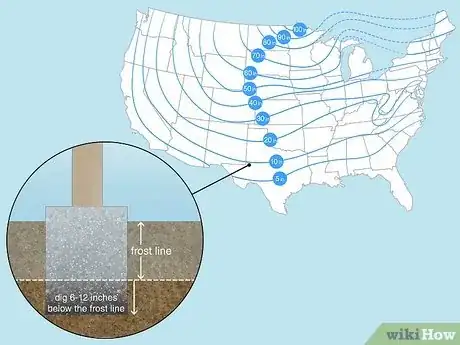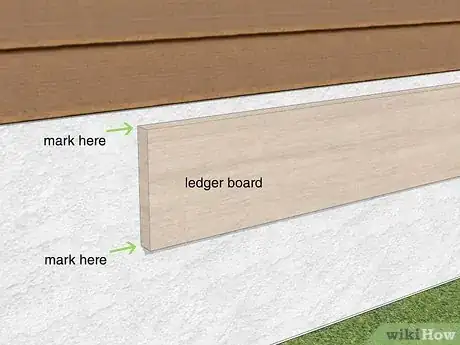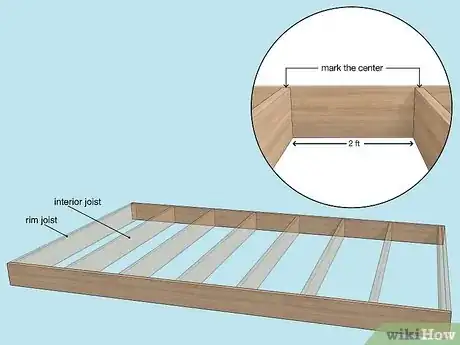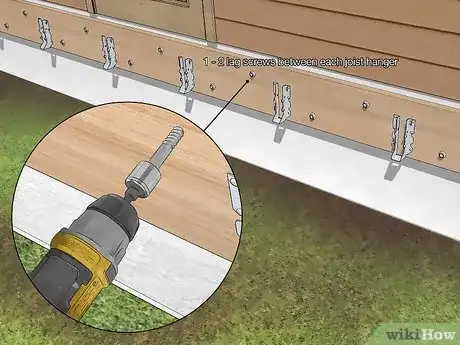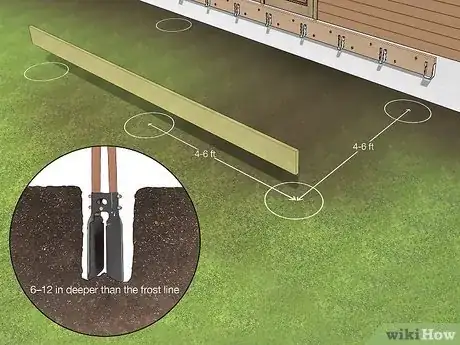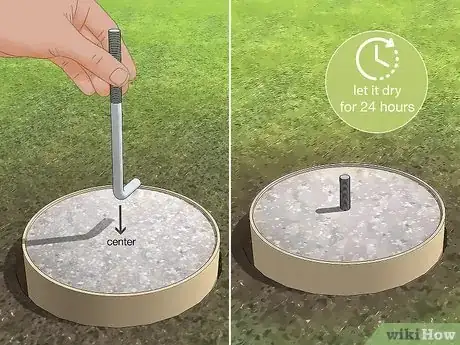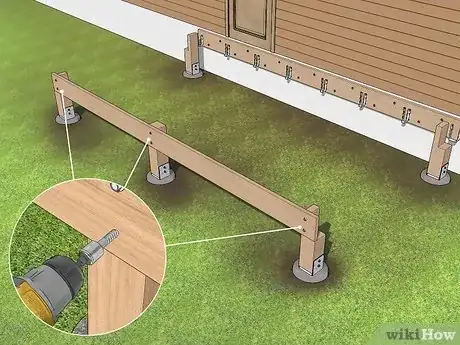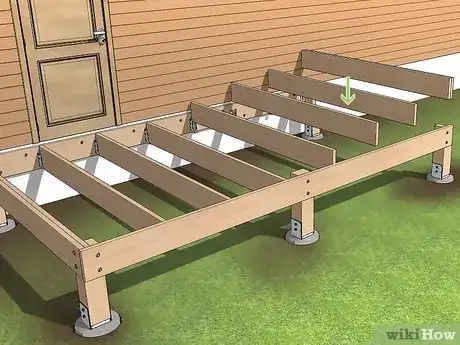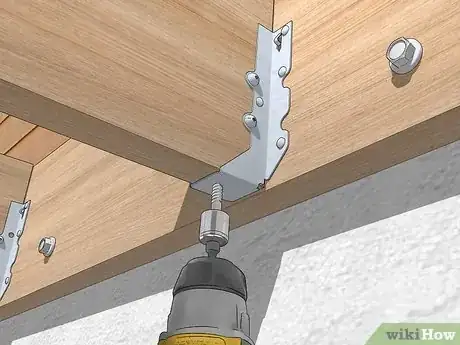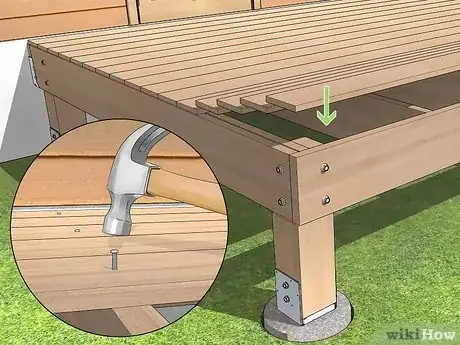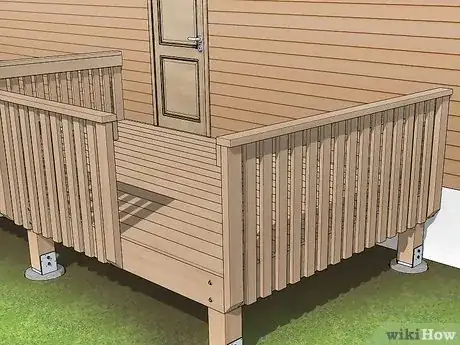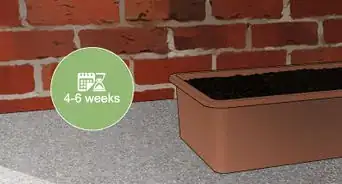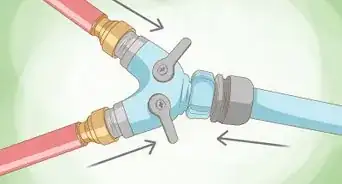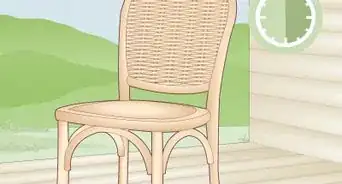This article was co-authored by wikiHow staff writer, Christopher M. Osborne, PhD. Christopher Osborne has been a wikiHow Content Creator since 2015. He is also a historian who holds a PhD from The University of Notre Dame and has taught at universities in and around Pittsburgh, PA. His scholarly publications and presentations focus on his research interests in early American history, but Chris also enjoys the challenges and rewards of writing wikiHow articles on a wide range of subjects.
There are 10 references cited in this article, which can be found at the bottom of the page.
This article has been viewed 9,582 times.
Learn more...
An elevated deck (also called a raised deck) offers a great outdoor extension of your indoor living space. While it’s not a job for beginners, adding a deck is a good DIY project with the right planning, skills, and equipment. We’ll walk you through the process from start to finish so you can build your own elevated deck—or so you’ll know what the job involves if you decide to hire a pro!
Steps
Putting Your Plan Together
-
1Research your local building codes and permitting process. The size and weight-bearing capacity of elevated decks are nearly always controlled by local building codes, so be sure to contact your locality’s code office before beginning your project. You’ll probably need to obtain a building permit as well in order to build an elevated deck (this may not be the case if you’re building an on-the-ground deck).[1]
- Don’t skip this step! Otherwise, you may discover the hard way that your homeowner’s insurance doesn’t cover injuries that occur on a deck that isn’t permitted and built according to code.
-
2Contact your local utilities to mark any buried lines on your property. Do this even if you think there’s no way there are any buried gas, water, or electrical lines in the area where you’re going to build the deck. It’s much better to be safe than sorry!
- In the U.S., call 811 before you dig.
Advertisement -
3Find out what the frost line is in your area, if applicable. If you live in an area that gets cold winters, the frost line is the average depth to which the ground freezes. You need to dig at least 6 in (15 cm) below the frost line—or perhaps 12 in (30 cm) or more according to your local building code—to install your deck piers and support posts. Otherwise, the annual freeze-thaw cycle may cause your deck to buckle and potentially fall.[2]
-
4Plan out the dimensions and building materials for the deck. Instead of just “guess-timating” the layout and materials list for your deck, create a specific plan for it. To simplify the process, work with an architect or use an online deck-designer tool to plan out the specifications for your elevated deck.[3]
- While the deck’s structure is typically made from pressure-treated lumber, you have several options for the decking boards you’ll be walking on. You can use a range of natural woods like cedar or redwood, composite (blended wood and plastic) decking, or PVC decking, to name just a few options.
- Many big-box home improvement stores and decking material producers offer free online deck design tools.
- Because this is an elevated deck, you’ll have to include railings in your design. You’ll also need stairs, unless you’re building more of a balcony-style deck that doesn’t have direct access to your yard.
Attaching the Ledger Board
-
1Mark the top and bottom lines for the deck on your home. Remove any siding so you can mark the lines on the sheathing underneath. Use a level and string a chalk line across the sheathing to mark a line where the top of the ledger board—the connection point between the deck and your home—will attach. Measure down the width of your ledger board—for example, 9.5 in (24 cm) if you’re using a 2 x 10 ledger board—and mark another level chalk line.[4]
- Remember to factor in the thickness of your decking boards, which will rest on top of the ledger board, when determining the height of your deck in relation to the exterior door you’ll use to access the deck. To reduce the chance of water infiltration (and to keep leaves from blowing in), it’s best to have the tops of the deck boards about 3 in (7.6 cm) below the door threshold.
- If you’re building the deck off the first level of your home, locate the bottom of the ledger board at least 1.5 in (3.8 cm) above the top of the concrete, stone, or brick foundation. This prevents water from leeching up from the foundation into the ledger board.
-
2Cut the ledger board and its opposing board to length. If your deck is going to be 10 ft (3.0 m) wide, for example, cut the ledger board to that length. Assuming that you’re building a square or rectangular deck—which you probably should be as a DIYer!—cut the opposing board that will be on the other side of the deck to the same length as the ledger board.[5]
- In most cases, the opposing board will be a mirror image of the ledger board—the same size, dimensions, and type of wood.
-
3Mark the joist locations on the ledger board and its opposing board. Start at the left side of the ledger board, marking on it the location for the left-side rim joist. Do the same for the right-side rim joist. (Keep in mind when marking these locations that the rim joists are typically 2 standard joists sandwiched together.) Then, mark off on the ledger board the center lines for the deck’s supporting joists that will be spaced out between the rim joists.[6]
- Repeat this joist-marking process on the ledger board’s opposing board as well.
- Since the joists will support the deck flooring and provide structural stability, proper spacing based on your design and weight-capacity needs is important. In general, deck joists are spaced 2 ft (61 cm) apart.
-
4Secure the joist hangers in place with nails. Set a joist hanger so it’s centered over one of the spacing lines you marked for the joists on the ledger board. Nail the hanger in place with joist hanger nails, which are fairly short and thick. Continue the process across both the ledger board and to its opposing board.[7]
-
5Attach the ledger board to the house with lag screws. Line up the ledger board with the lines you put on the house, then temporarily tack it in place with nails. Drill holes into the ledger board for the lag screws—space out either 1 or 2 holes between each joist hanger, depending on how many lag screws you plan calls for. Add a dollop of silicone caulk to each drill hole, then use an impact wrench to sink a lag screw—minimum 1⁄2 in (1.3 cm) diameter—into each hole.[8]
Setting the Footings and Posts
-
1Mark out and dig holes for the footings. Lay out the locations for the footings by running string lines between wood stakes pounded into the ground—use a tape measure and level to make sure the layout is correct. Once you’ve marked each footer location, use either a post-hole digger or power auger to dig the footing holes at least 6–12 in (15–30 cm) deeper than the frost line in your area.[9]
- Generally speaking, deck footings are spaced about 4–6 ft (1.2–1.8 m) apart, and rarely if ever more than 8 ft (2.4 m) apart.
- Depending on where you live, your local building inspector may need to check the holes for depth before you can continue.
- Remember to call 811 to have your utility lines marked before you start digging.
-
2Set pier forms in the holes and add concrete. Place a tubular concrete pier form—typically made of either plastic or heavy-duty cardboard—into each hole, then trim the tops of each form as needed so they’re all level. Loosely add backfill around all the forms to hold them in place, then fill each form with concrete.[10]
- Choose a concrete mix that’s intended for use in footings and mix it according to the product instructions.
-
3Sink anchor bolts into the concrete while it’s still wet. Center an anchor bolt (also called a J-bolt) over a concrete-filled pier form and sink the hooked end down into the concrete until only the threaded top portion of the bolt is visible. Repeat this with all the other pier locations, then let the concrete dry for at least 24 hours before moving on to the next step.[11]
- Use anchor bolts that coordinate with the metal post bases you’ve chosen to use to attach the deck posts to the concrete footings.
-
4Secure the post bases to the footings once the concrete has dried. Slip a post base over one of the exposed anchor bolts, then slide on a washer and nut. Hand-tighten the nut for now—you can tighten it fully once you confirm everything is in the proper position. Attach the other post bases in the same fashion.[12]
- Post bases are designed to keep the wood posts from coming in direct contact with the concrete footings. Without them, moisture will wick up from the concrete into the wood and may cause it to rot prematurely.
-
5Connect the wood posts to the post bases. Set one of the posts down into one of the post bases, check for fit and positioning, then move the post and fully tighten the nut on the post base’s anchor bolt. Return the wood post to its position and lock it in place with the structural screws that come with the post base. Attach all the other posts the same way.[13]
- Regularly check to confirm that the posts are level and square. Temporarily hold them in the proper position with braces made of scrap lumber.
- Cut off the tops of the posts to the correct height once all of them are in place.
Laying the Floor Structure and Decking
-
1Secure the ledger board’s opposing board to the posts. Set the board—which may be a pair of 2 x 10 boards sandwiched together, depending on your design and local building code—on the posts at the far end of the deck. Once you confirm the board is square and level, attach it with lag screws or lag bolts.[14]
-
2Attach the rim joists to the ledger board and its opposing board. Slide the rim joists—which, along with the ledger board and its opposing board, complete the perimeter of your deck—into the joist hangers at the ends of the ledger board and its opposing board. Secure them in place with galvanized nails or decking screws.[15]
- Continue to regularly check for level and square as you work.
- If you’re using pressure-treated lumber, brush some end-grain sealer onto the cut ends to help prevent rot.
-
3Attach the remaining joists to the joist hangers. Before installation, look down the length of each joist and check signs of bowing (called a crown). If you see a crown, install the joist with the crown pointing up so it will flatten out over time. Secure all the joists into place by driving nails or screws through the hangers.[16]
- Tap the joists into place with a hammer if it’s a snug fit between the joist hangers. However, trim off a bit of the joist instead of bashing at it with the hammer in order to squeeze it into the hangers. The joists need a bit of room for natural expansion and contraction with the weather.
-
4Install the deck boards on the joists. Start at the ledger board and cut the first 2 deck boards exactly to length—either equal to the width between the rim joists or slightly wider to account for any skirting you plan to add later. The other deck boards can be cut to length after installation with a circular saw or jigsaw. Install the first deck board flush against the house, driving 2 deck screws through the board and into each joist.[17] For each subsequent deck board, leave a space equivalent to the width of a 10-penny nail—about 1⁄4 in (0.64 cm)—between boards to allow for water drainage.[18]
- If you’re using composite or PVC decking, you might be instructed to use a special decking jig that allows you to drive screws or nails into the sides of the deck boards instead of straight down from above. This makes the fasteners invisible once the deck is complete.
- If your deck is wider than your deck boards, cut the boards so they join right over a joist. Stagger these joints with each row of deck boards so they don’t all end up on the same joist.
Adding Skirting, Railings, and Stairs
-
1Cover the rim joists and beam with a skirting board if desired. A skirting board is an optional element that is simply used to conceal the structural wood beneath. If you choose to add one, cut the skirting boards—you might use 2 x 10 boards, for instance—to length and nail or screw them to the rim joists and the beam that runs opposite to the ledger board. Use simple butt joints instead of angled miter joints at the corners to limit noticeable gaps when the wood expands and contracts with the weather.[19]
- Add the skirting board before installing the railings and stairs. Or just skip this optional element and move on to those components of the deck.
-
2Install deck railings according to code. All elevated decks need railings as a safety measure, and your local building code will dictate elements such as height and spacing. Adding a railing varies based on a lot of design and code factors, but here’s a general rundown:[20]
- Cut notches into the bottoms of the 4 x 4 (or similar) posts so they will partially rest on the decking and partially overhang the deck.
- Secure the posts through the skirting board and into the rim joists or beam with at least 2 lag screws or carriage bolts per post.
- Carefully measure the spacing between posts, then cut and assemble the top and bottom rails and balusters as a unit. Attach each section of railing and balusters between the posts with 3 in (7.6 cm) screws.
-
3Build stairs as needed for deck access. Not all elevated decks have stairs, but you’ll need them if you want to access your deck from outside! Building deck stairs is a rather complex process that requires strong math and construction skills, so it’s okay to think about hiring a pro just for this element. That said, here’s a quick summary of the process:[21]
- Use math (perhaps with the help of an online design tool) to design stairs that meet your local building code—for example, deck stairs often need to be at least 36 in (91 cm) wide, at least 10 in (25 cm) in tread depth, and no more than 7.75 in (19.7 cm) in height per step.
- Cut the left, right, and center stringers (the supports for the stair treads) out of 2 x 12 boards and attach them to the deck structure with corner brackets, L-brackets, and 3 in (7.6 cm) deck screws.
- Cut the risers (the vertical part of each step) and attach them to the stringers with deck screws.
- Trim 1.5 x 10 tread boards to length and connect them to the stringers with 3 in (7.6 cm) deck screws.
- Add posts and railings in the same way as those on the deck, but this time factoring in for the angle of the stairs.
Things You'll Need
- Deck posts (4 x 4s or 6 x 6s)
- Beams (4 x 6s, 4 x 8s or 4 x 10s, or double or triple layers of 2 x 6s, 2 x 8s or 2 x 10s)
- Joists (2 x 6s, 2 x 8s or 2 x 10s)
- Stair stringers (2 x 12s)
- Deck boards (2 x 4s, 2 x 6s or 5/4 x 6s)
- Stair treads (same material as deck boards)
- Railing posts (4 x 4s)
- Rails (2 x 4s or 2 x 6s)
- Spindles (2 x 2s)
- Skirting boards (1 x 8s, 1 x 10s or 1 x 12s)
- Concrete (ready-mixed or bagged)
- Concrete pier blocks
- Joist hangers
- Common and casing nails (galvanized or coated, 8-, 10- and 16-penny sizes)
- Screws (galvanized or coated, 2 1/2-inch/6.25 centimeter and 3 1/2-inch/8.75 centimeter)
- Lag screws and washers
- Carriage bolts, nuts and washers
References
- ↑ https://www.thisoldhouse.com/ideas/read-you-build-your-deck
- ↑ https://thehonestcarpenter.com/blog/depth-of-footings/
- ↑ https://www.thisoldhouse.com/ideas/read-you-build-your-deck
- ↑ https://inspectapedia.com/decks/Deck_Ledger_Board.php
- ↑ https://www.popularmechanics.com/home/outdoor-projects/how-to/a23949/how-to-build-a-deck/
- ↑ https://www.popularmechanics.com/home/outdoor-projects/how-to/a23949/how-to-build-a-deck/
- ↑ https://www.popularmechanics.com/home/outdoor-projects/how-to/a23949/how-to-build-a-deck/
- ↑ https://www.popularmechanics.com/home/outdoor-projects/how-to/a23949/how-to-build-a-deck/
- ↑ https://www.popularmechanics.com/home/outdoor-projects/how-to/a23949/how-to-build-a-deck/
- ↑ https://www.popularmechanics.com/home/outdoor-projects/how-to/a23949/how-to-build-a-deck/
- ↑ https://youtu.be/95_jg0Hms1s?t=156
- ↑ https://youtu.be/95_jg0Hms1s?t=156
- ↑ https://youtu.be/95_jg0Hms1s?t=156
- ↑ https://www.popularmechanics.com/home/outdoor-projects/how-to/a23949/how-to-build-a-deck/
- ↑ https://aibd.org/attach-deck-ledger-rim-board/
- ↑ https://www.popularmechanics.com/home/outdoor-projects/how-to/a23949/how-to-build-a-deck/
- ↑ https://www.popularmechanics.com/home/outdoor-projects/how-to/a23949/how-to-build-a-deck/
- ↑ https://www.thisoldhouse.com/decking/21018288/read-this-before-you-build-your-deck
- ↑ https://homedecorbliss.com/deck-skirting-ideas/
- ↑ https://www.thisoldhouse.com/porches/21017069/how-to-build-a-porch-rail
- ↑ https://www.thisoldhouse.com/decking/21017297/how-to-build-deck-stairs


